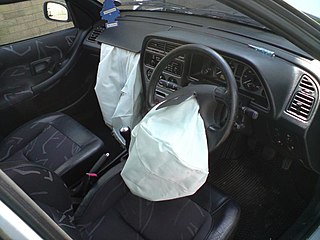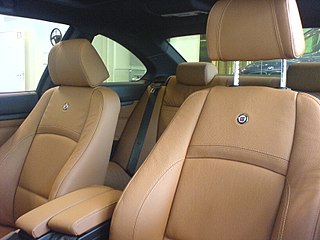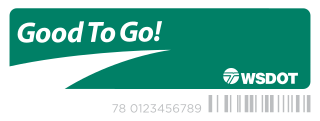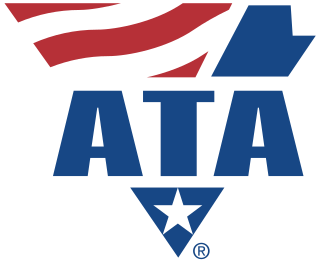Related Research Articles

A seatbelt is a vehicle safety device designed to secure the driver or a passenger of a vehicle against harmful movement that may result during a collision or a sudden stop. A seat belt reduces the likelihood of death or serious injury in a traffic collision by reducing the force of secondary impacts with interior strike hazards, by keeping occupants positioned correctly for maximum effectiveness of the airbag and by preventing occupants being ejected from the vehicle in a crash or if the vehicle rolls over.

A high-occupancy vehicle lane is a restricted traffic lane reserved for the exclusive use of vehicles with a driver and one or more passengers, including carpools, vanpools, and transit buses. These restrictions may be only imposed during peak travel times or may apply at all times. According to the criteria used there are different types of lanes: temporary or permanent with concrete barriers; two-directional or reversible; and exclusive, concurrent or contraflow lanes working in peak periods. The normal minimum occupancy level is 2 or 3 occupants. Many jurisdictions exempt other vehicles, including motorcycles, charter buses, emergency and law enforcement vehicles, low-emission and other green vehicles, and/or single-occupancy vehicles paying a toll. HOV lanes are normally created to increase average vehicle occupancy and persons traveling with the goal of reducing traffic congestion and air pollution, although their effectiveness is questionable.

An airbag is a vehicle occupant-restraint system using a bag designed to inflate extremely quickly, then quickly deflate during a collision. It consists of the airbag cushion, a flexible fabric bag, an inflation module, and an impact sensor. The purpose of the airbag is to provide a vehicle occupant with a soft cushioning and restraint during a crash event. It can reduce injuries between the flailing occupant and the interior of the vehicle.

An intelligent transportation system (ITS) is an advanced application which aims to provide innovative services relating to different modes of transport and traffic management and enable users to be better informed and make safer, more coordinated, and 'smarter' use of transport networks.

Automotive safety is the study and practice of design, construction, equipment and regulation to minimize the occurrence and consequences of traffic collisions involving motor vehicles. Road traffic safety more broadly includes roadway design.

Road traffic safety refers to the methods and measures used to prevent road users from being killed or seriously injured. Typical road users include pedestrians, cyclists, motorists, vehicle passengers, horse riders, and passengers of on-road public transport.

Carpooling is the sharing of car journeys so that more than one person travels in a car, and prevents the need for others to have to drive to a location themselves.
The Texas A&M Transportation Institute (TTI) in College Station, Texas is the largest transportation research agency in the United States. Created in 1950, primarily in response to the needs of the Texas Highway Department, TTI has since broadened its focus to address all modes of transportation–highway, air, water, rail, pipeline, and automated/connected vehicles. TTI is a state agency and a member of the Texas A&M University System. TTI’s cooperative relationship with the Texas Department of Transportation has helped the Institute develop and implement work for numerous other sponsors.

A car seat is the seat used in automobiles. Most car seats are made from inexpensive but durable material in order to withstand prolonged use. The most common material is polyester.

The National Highway Traffic Safety Administration is an agency of the U.S. federal government, part of the Department of Transportation. It describes its mission as "Save lives, prevent injuries, reduce vehicle-related crashes" related to Transportation safety in the United States.

A rollover is a type of vehicle crash in which a vehicle tips over onto its side or roof. Rollovers have a higher fatality rate than other types of vehicle collisions.
The National Traffic and Motor Vehicle Safety Act was enacted in the United States in 1966 to empower the federal government to set and administer new safety standards for motor vehicles and road traffic safety. The Act was the first mandatory federal safety standards for motor vehicles. The Act created the National Highway Safety Bureau. The Act was one of a number of initiatives by the government in response to increasing number of cars and associated fatalities and injuries on the road following a period when the number of people killed on the road had increased 6-fold and the number of vehicles was up 11-fold since 1925. The reduction of the rate of death attributable to motor-vehicle crashes in the United States represents the successful public health response to a great technologic advance of the 20th century—the motorization of America.

The El Monte Busway is an 11-mile (18 km) shared-use express bus corridor (busway) and high occupancy toll lane running west along Interstate 10 from Interstate 605 and El Monte Station in El Monte, California, via busway stations at Cal State LA station and LA County+USC Medical Center station into Downtown Los Angeles and its terminus at Union Station.

Good to Go, stylized as Good To Go!, is the electronic toll collection system used by the Washington State Department of Transportation on all current toll projects in the U.S. state of Washington. Good to Go customers prepay a balance into an account and the tolls are then electronically deducted as the customer passes through an electronic toll collection location. Vehicles that are not linked to an account are photographed and a toll bill is sent to the registered owner by U.S. mail. The system debuted in July 2007 on the new Tacoma Narrows Bridge and is a part of the high-occupancy toll (HOT) lanes on State Route 167, which opened in the spring of 2008. All-electronic tolling began on the SR 520 Bridge on December 29, 2011. The Good to Go system is similar to other electronic tolling technology already in place around the country such as FasTrak in California and E-ZPass in the eastern United States.

The American Trucking Associations (ATA), founded in 1933, is the largest national trade association for the trucking industry. ATA represents more than 37,000 members covering every type of motor carrier in the United States through a federation of other trucking groups, industry-related conferences, and its 50 affiliated state trucking associations. Former Governor of Kansas Bill Graves was replaced by Chris Spear as the ATA's President and CEO in July 2016.

A run-off-road collision is a US term for a type of single-vehicle collision that occurs when a vehicle leaves the roadway.

A high-occupancy toll lane is a type of traffic lane or roadway that is available to high-occupancy vehicles and other exempt vehicles without charge; other vehicles are required to pay a variable fee that is adjusted in response to demand. Unlike toll roads, drivers have an option to use general purpose lanes, on which a fee is not charged. Express toll lanes, which are less common, operate along similar lines, but do not exempt high-occupancy vehicles.
The Metro ExpressLanes project is a transport project in Los Angeles County, California that debuted in 2012 to "improve traffic flow and provide enhanced travel options on I-10 and I-110 in Los Angeles County". It includes a range of infrastructure developments on the Harbor Transitway and the El Monte Busway. The existing high-occupancy lanes on these transitways were converted to high occupancy toll (HOT) lanes. Associated works included a major upgrade to El Monte bus station, expansion of Metrolink's Pomona Station, the creation of a new transit station at Union Station and increased park and ride capacity and bike lockers at many transit stations. In addition, new vanpool vehicles and buses will be purchased. The project was delivered by the Los Angeles County Metropolitan Transportation Authority, the California Department of Transportation, and others. The budget was $290 million and construction, which began in 2011, was completed in February 2013. Some transit improvements for the Metro Silver Line are still being worked on.

People who are driving as part of their work duties are an important road user category. First, workers themselves are at risk of road traffic injury. Contributing factors include fatigue and long work hours, delivery pressures, distractions from mobile phones and other devices, lack of training to operate the assigned vehicle, vehicle defects, use of prescription and non-prescription medications, medical conditions, and poor journey planning. Death, disability, or injury of a family wage earner due to road traffic injury, in addition to causing emotional pain and suffering, creates economic hardship for the injured worker and family members that may persist well beyond the event itself.

A managed lane is a type of highway lane that is operated with a management scheme, such as lane use restrictions or variable tolling, to optimize traffic flow, vehicle throughput, or both. Definitions and goals vary among transport agencies, but managed lanes are generally implemented to achieve an improved operational condition on a highway, such as improving traffic speed and throughput, reducing air pollution, and improving safety. Types of managed lanes include High-occupancy vehicle (HOV) lanes, High-occupancy toll lanes, express toll lanes, reversible lanes, and bus lanes. Most managed lane facilities are located in the United States, although HOV and bus lanes can be found in many other countries; outside of the US, many countries use active traffic management that manage all lanes of a highway.
References
- ↑ Newsday Oct 1, 2001
- ↑ Mannering, Fred L., Walter P. Kilareski, and Scott S. Washburn. Principles of Highway Engineering and Traffic Analysis. New Delhi: Wiley-India, 2009.
- ↑ National Research Council (U.S.). Special Report - Transportation Research Board, National Research Council. Washington, D.C.: Transportation Research Board, National Research Council, 1974.
| This road-related article is a stub. You can help Wikipedia by expanding it. |